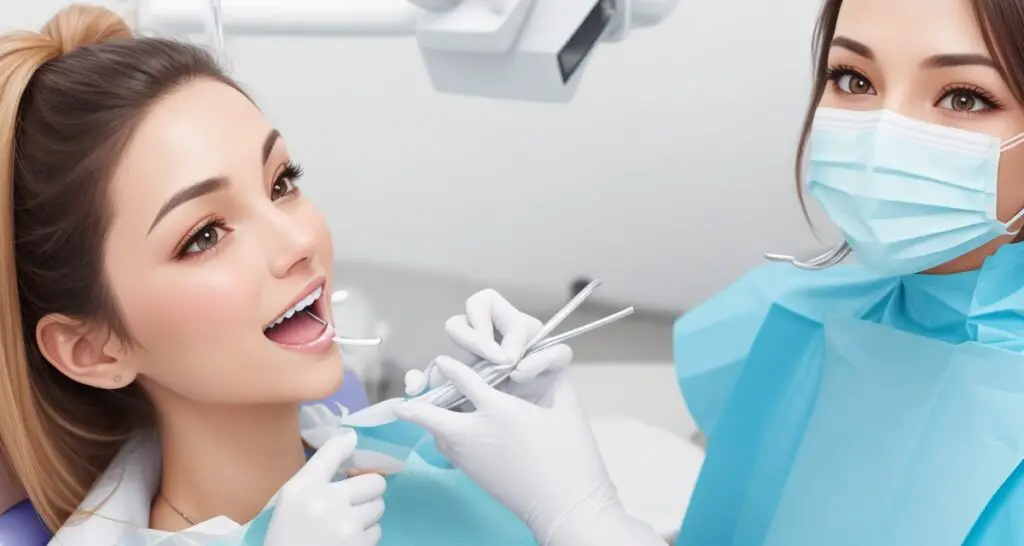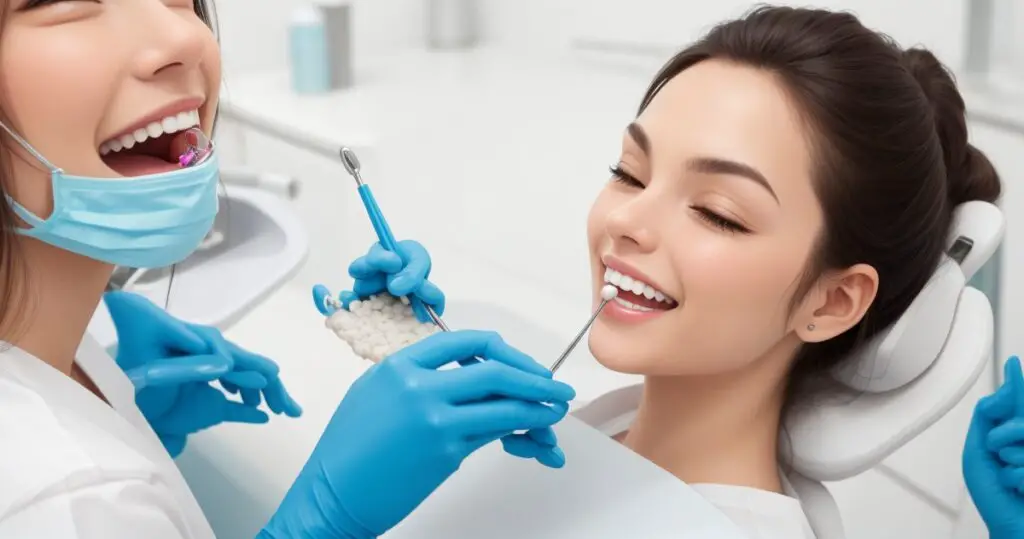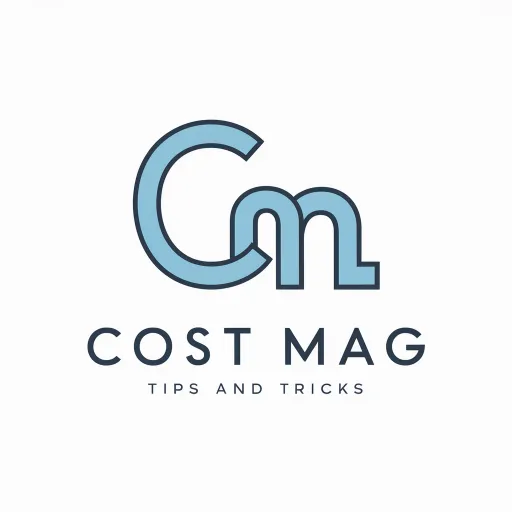When it comes to maintaining optimal oral health, one common question that often arises is, “How much does it cost for a dental cleaning?” Regular dental cleanings are a fundamental aspect of preventive dental care, essential for keeping your teeth and gums in top condition.
The cost of a dental cleaning can vary depending on several factors, including location, the type of cleaning required, and whether you have dental insurance. In this article, we will explore the various factors that can influence the cost of a dental cleaning, helping you gain a better understanding of what to expect when you visit your dentist for this essential aspect of oral hygiene.
The Importance of Dental Cleanings
Dental cleanings are unquestionably a priceless investment in your oral health. They serve as a vital preventive measure to ensure the well-being of your teeth and gums, effectively guarding against gum disease and the irreversible loss of teeth. By forgoing dental cleanings, you significantly increase your statistical risk of tooth loss and the onset of preventable oral diseases.
These routine dental cleanings, often referred to as “prophys” or “prophylaxis,” are inherently focused on prevention, and the returns they yield are invaluable in terms of averting otherwise avoidable dental problems.
Dental cleanings play a pivotal role in maintaining oral health and overall well-being. By having these professional cleanings on a regular basis, you benefit from a multitude of advantages that extend far beyond just clean teeth. Let’s delve into the deeper intricacies of their importance.
Preventing Gum Disease:
Dental cleanings are your first line of defense against gum disease. During a cleaning, dental professionals remove plaque and tartar buildup, which, if left untreated, can lead to periodontal disease. This condition not only causes gum inflammation and bleeding but can also result in tooth loss.
Avoiding Tooth Loss:
The primary goal of dental cleanings is to safeguard your teeth. The removal of plaque and tartar prevents tooth decay and subsequent tooth loss. Losing teeth can be a distressing experience, affecting your self-esteem and overall quality of life.
Oral Health and General Health Connection:
Emerging research has highlighted the profound link between oral health and general health. Regular dental cleanings not only protect your mouth but can also reduce the risk of systemic health issues, including heart disease, diabetes, and respiratory infections.
Early Detection of Issues:
Routine cleanings provide an opportunity for early detection of dental issues. Your dental professional can identify potential problems such as cavities, fractures, or oral cancers in their early stages when they are more manageable and less costly to treat.
A Bright and Confident Smile: Cleanings not only contribute to a healthy mouth but also result in a brighter, whiter smile. The removal of stains and plaque buildup enhances your appearance and boosts your self-confidence.
The Consequences of Neglecting Professional Teeth Cleaning

No matter how impeccable your oral hygiene routine may be, it’s common to experience occasional plaque and tartar buildup. Regular preventive dental cleanings serve as a gentle and effective means to eliminate these areas of buildup, essentially providing you with a “clean slate” to maintain your oral health.
Without these crucial cleanings, tartar will persistently accumulate below the gumline. Over time, this accumulation can lead to the gum tissues pulling away, resulting in the formation of deep pockets beneath them and bone loss around the tooth’s root. Without timely intervention, the inevitable outcome is tooth mobility and eventual loss.
It’s essential to recognize that the cost of biannual dental cleanings, even when not covered by insurance, is a relatively small investment compared to the potential risk of losing teeth due to tartar buildup. Since these cleanings are wholly preventive in nature, their primary purpose is to assist you in safeguarding your smile and, remarkably, saving you money in the long run.
Here’s a closer look at the significant consequences of neglecting professional teeth cleaning:
Gum Health and Tooth Mobility:
Tartar buildup can lead to gum recession and the creation of deep pockets around teeth. This can result in tooth mobility, making it difficult to chew and speak comfortably.
Bone Loss: As tartar accumulates and gum recession occurs, bone loss can follow. This may weaken the foundation of your teeth, increasing the risk of tooth loss.
Tooth Loss: The ultimate consequence of neglecting professional cleanings is the potential loss of teeth. Losing teeth can affect your appearance, self-confidence, and overall quality of life.
Financial Considerations: Preventive dental cleanings, although they may seem like an Expense, are a cost-effective investment when compared to the extensive dental treatments required to address advanced gum disease or tooth loss.
Oral and Overall Health: Neglecting professional cleanings can impact not only your oral health but also your overall well-being. Gum disease is linked to systemic health issues, making prevention a crucial aspect of your healthcare.
How Frequent Should Dental Checkups Be?

For individuals blessed with strong and healthy teeth and gums, the standard recommendation is to schedule dental visits with your dentist and hygienist twice a year, which equates to every six months. These appointments encompass comprehensive exams and professional cleanings, ensuring that your oral health remains in its best possible condition.
It’s worth mentioning that, while the cost of teeth cleaning may raise concerns, certain circumstances warrant more frequent cleanings, typically occurring every 3-4 months. Such situations include those with fixed orthodontic appliances or individuals who have previously undergone treatments for gum disease. Here’s a more in-depth look at the considerations for various dental checkup frequencies:
Biannual Dental Visits:
Semi-annual dental checkups, occurring every six months, are suitable for most individuals with healthy teeth and gums. These routine appointments offer an opportunity for early detection of dental issues and professional cleanings to maintain oral hygiene.
More Frequent Cleanings:
Some people may benefit from dental visits every 3-4 months, especially if they have fixed orthodontic appliances like braces. These devices can make cleaning teeth more challenging, increasing the risk of plaque buildup. Individuals with a history of gum disease may require more frequent cleanings to manage their condition effectively.
Customized Dental Care:
Your dentist will assess your specific oral health needs and recommend a personalized schedule. Factors such as your dental history, overall health, and any ongoing treatments will influence the frequency of your dental visits.
Preventive Approach:
While it’s natural to consider the cost of dental care, it’s essential to approach it from a preventive perspective. Regular dental checkups help identify and address issues in their early stages, potentially reducing the need for more extensive and costly treatments down the road.
Patient Comfort:
Your comfort and confidence in your oral health are paramount. If you ever have questions or concerns about the frequency of your dental visits, do not hesitate to discuss them with your dentist. They will work with you to ensure your oral care aligns with your unique needs and circumstances.
Factors Influencing the Cost of Dental Cleanings

While providing an exact quote for teeth cleaning costs may not be feasible, we can certainly shed light on the key factors that influence the price you can expect to pay for your dental appointment:
Location Matters:
The geographical area in which you reside plays a significant role in determining dental cleaning costs. Areas with a higher cost of living tend to have increased operating expenses for dental practices, which encompass expenses like rent, laboratory costs, and staff salaries. As a general rule, dental cleaning costs are often more budget-friendly in rural areas.
Type of Cleaning Required:
The nature of the cleaning needed affects the cost. Preventative cleanings are typically the most cost-effective and are often covered by insurance. In contrast, treatments such as periodontal therapy or deep cleaning teeth incur higher costs due to the Time and specialized procedures involved.
How Much Does a Teeth Cleaning Cost Without Insurance?
The cost of dental exams can differ depending on a number of variables, such as your age, where you live, what sort of cleaning you require, and what insurance you have. It’s important to consider whether you plan to buy about whether you plan on buying independent dental insurance when weighing the cost of dental care. Regular cleanings are usually fully reimbursed by many insurance plans, but if you don’t have insurance, they typically run you between $100 and $200.
Dental health is just as important as traditional medical treatment. Maintaining your general health and well-being is contingent upon having access to a comprehensive medical plan that is both inexpensive and simply manageable. You may obtain affordable lab testing, urgent care appointments, and lower costs on prescription drugs with a Mira membership.
The Price of Dental Cleaning without Insurance

We understand that not everyone has dental insurance, and that’s absolutely fine. Your local dentist is more than happy to collaborate with you to create a plan that enables you to receive the essential dental cleanings you need. Fortunately, dental cleanings are quite reasonably priced when compared to potential future treatments that may become necessary if oral health is neglected.
The cost of dental cleanings before insurance comes into play can vary, depending on the specific dental office you visit. It’s also influenced by the extent of cleaning required. If you require a deep dental cleaning, the cost may be higher than that of a regular cleaning. Deep dental cleanings might necessitate multiple sessions, so please keep that in mind.
How Much Does It Cost For A Dental Cleaning?
The average cost of a dental cleaning in Texas falls within the range of $100 to $200. As mentioned earlier, various factors, including the dental practice you choose and the extent of cleaning needed, can affect this cost. New patients typically undergo an initial examination that includes X-rays, which may bring the cost of your first visit to around $300 or $400. It’s essential to note that routine dental cleanings are recommended twice a year, so you aren’t paying for a cleaning every month. By setting aside $20-$30 per month, you can easily build up savings to cover the cost of a dental cleaning without insurance.
The Expense of Dental Cleaning with Insurance

If you are fortunate to have dental insurance, it’s advisable to take a close look at your insurance coverage to ensure you’re fully informed and won’t be surprised by unexpected out-of-pocket expenses. Dental insurance functions a bit differently from your health insurance, as it typically includes an annual limit that the insurance company covers before you become responsible for any Costs. Your share of the cost depends on the specific dental service provided.
In most cases, dental insurance plans cover two dental cleanings per year, and these are fully paid for by your insurance company. It’s important to assess your current oral health when deciding whether dental insurance is a worthwhile investment. On average, dental insurance premiums can range from $15 to $50 per month. If you receive a higher-end monthly premium quote and have relatively good dental health, it might be more cost-effective to pay for dental services out of pocket.
For other dental procedures, such as cavity fillings and periodontal treatments, you can anticipate paying a portion of the service cost. Typically, dental insurance covers around 70% to 80% of these costs, potentially reducing your co-pay to less than $50. However, for more extensive procedures like crowns, implants, and root canals, the coverage may be 50% or less.
Initially, this might appear as an excellent arrangement. However, if you require extensive dental work, you could quickly reach the annual limit set by your dental insurance. Once you reach this limit, you will be responsible for 100% of any Dental care expenses until the next year.
Exploring the Four Key Types of Dental Cleanings
Dental cleanings come in various forms, each tailored to specific needs and intricacies. Let’s delve into these four primary types of dental cleanings:
Adult Teeth Cleaning
A typical adult teeth cleaning, known as prophylaxis, typically spans 45-60 minutes and is recommended every six months. During this friendly and efficient session, your dental hygienist carefully removes plaque and tartar, ensuring your oral health stays in top shape.
Child Teeth Cleaning
Children’s dental cleanings differ, mainly due to the smaller size and reduced number of teeth. These appointments usually require less time since young ones typically have less tartar buildup. The process remains gentle and engaging to instill good oral habits from an early age.
Scaling and Root Planing (Deep Cleaning/SCRP)
When gum disease is a concern, deep cleaning, or scaling and root planing, is the go-to solution. This thorough treatment reaches below the gumline, targeting tartar buildup along the root surfaces of teeth. Deep cleanings are often divided into “quadrants,” treating half of your mouth at a time. They are vital in halting gum disease progression and preventing bone loss.
Periodontal Maintenance
After a deep cleaning, the journey continues with periodontal maintenance appointments, scheduled at 3-4-month intervals. These friendly follow-up sessions aim to prevent any relapse of gum disease and maintain the progress achieved during the deep cleaning.
Anticipating Your Dental Cleaning Experience
A standard dental cleaning, often referred to as a six-month prophylaxis, is a comprehensive procedure that ensures the health and vitality of your smile. Here’s what you can expect during this friendly and informative session:
Plaque and Tartar Removal:
Your skilled hygienist will employ special scalers or an ultrasonic instrument to meticulously eliminate surface plaque and tartar from your teeth. Typically, the areas of heaviest buildup include along the gumlines, between your back teeth, and just behind your lower front teeth. It may appear as if your hygienist is navigating different areas throughout your mouth, but rest assured, these unique instruments are designed for specific contact points. Each hygienist adheres to a distinct pattern, ensuring that your teeth receive a thorough and complete cleaning.
Polishing for a Radiant Smile:
Following the scaling process, your hygienist will use a specialized polishing tool to gently buff away surface stains, leaving your teeth with a gleaming finish. This step enhances not only the appearance of your smile but also your confidence.
Comprehensive Checkup:
Your dental cleaning is a vital component of your overall checkup appointment. To the cleaning, other essential steps include a periodontal screening to assess gum health, an oral cancer examination for early detection, a TMJ (Temporomandibular Joint) assessment to evaluate jaw health, and, of course, an in-depth examination with the dentist to address any specific concerns or treatments required.
FAQS;
How much does a dental cleaning cost on average?
On average, the cost of a dental cleaning can vary widely depending on factors such as location, the type of cleaning required, and insurance coverage. However, you can typically expect the cost to range from $75 to $200 for a routine dental cleaning without insurance.
Does dental insurance cover the cost of dental cleanings?
Yes, most dental insurance plans cover the cost of routine dental cleanings. Typically, these plans offer 100% coverage for preventive services like cleanings, making them an excellent option for managing dental care costs.
Are there any additional costs associated with dental cleanings?
While routine dental cleanings are generally straightforward, there may be Costs if you require more extensive cleaning procedures or if you have dental issues that need to be addressed during the appointment. It’s essential to discuss any potential extra costs with your dentist beforehand.
How can I save on the cost of dental cleanings without insurance?
You can explore dental savings plans, which offer discounts on various dental services, including cleanings. Some dental schools and community health clinics may provide affordable or sliding-scale fee options for dental cleanings.
What factors can increase the cost of dental cleaning?
Several factors can lead to increased cleaning costs, such as the need for deep cleaning due to gum disease, the use of advanced technologies, or Procedures like X-rays or fluoride treatments.
Conclusion
The cost of a dental cleaning can vary based on multiple factors, including location, type of cleaning required, and insurance coverage. On average, a routine dental cleaning without insurance typically ranges from $75 to $200. However, investing in dental cleanings is crucial for maintaining oral health and preventing more extensive and costly dental issues in the future.
If you’re concerned about the cost, consider exploring dental insurance options, dental savings plans, or low-cost dental clinics in your area to make dental cleanings more affordable and accessible. Prioritizing regular cleanings is a wise step toward preserving your smile and overall well-being.

